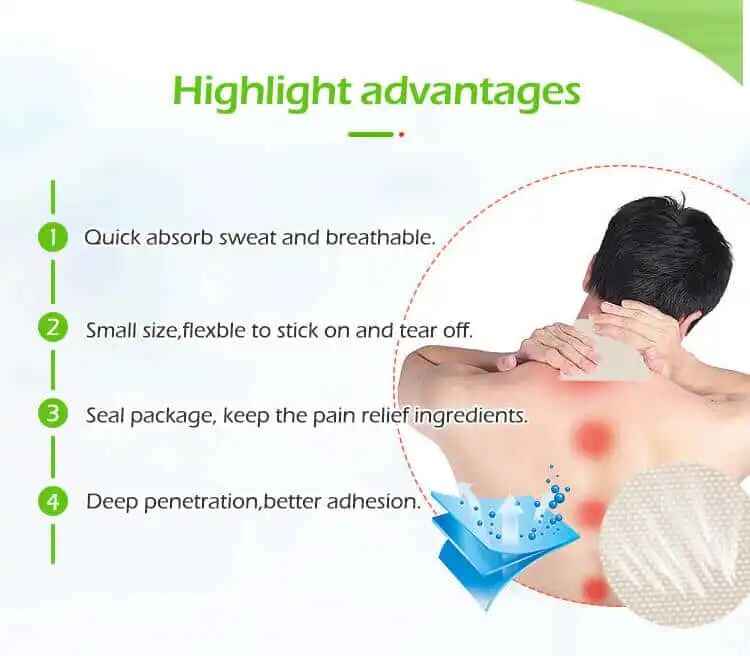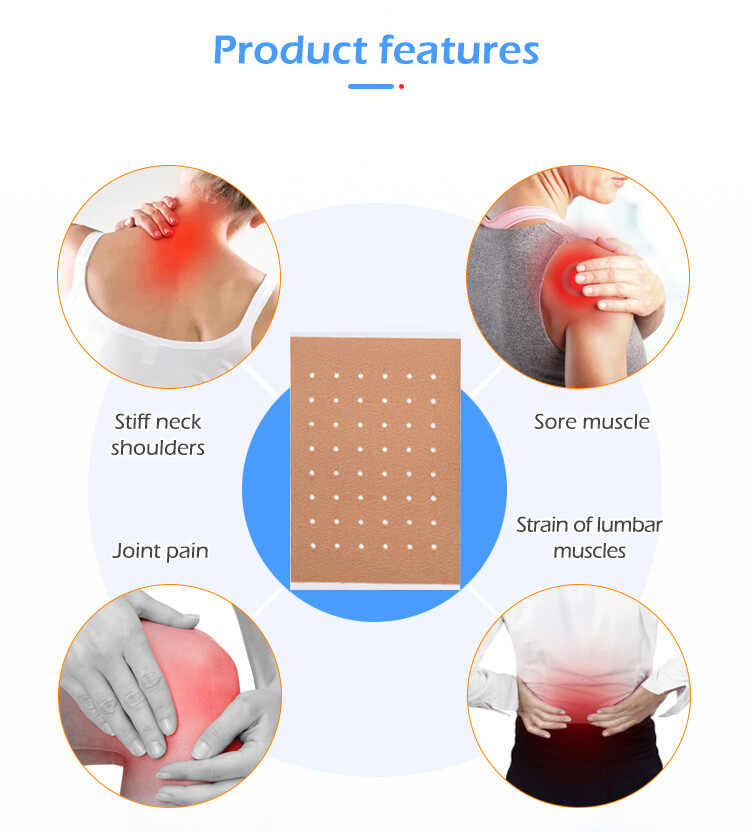What Are the Common Materials Used in Heat Therapy Patch Production?
When developing a Custom Heat Therapy Patch, the selection of materials plays a crucial role in both the functionality and safety of the product. Whether you’re working with a Heat Therapy Patch Manufacturer or a Heat Therapy Patch OEM, understanding the key materials used in heat therapy patches is essential for ensuring quality, durability, and compliance with regulatory standards. This article will dive into the common materials used in the production of Private Label Heat Therapy Patches and explore their roles in delivering effective, safe, and comfortable heat therapy.

1. Adhesive Layer
The adhesive layer is one of the most crucial components of a Heat Therapy Patch. It serves to securely attach the patch to the skin, ensuring that the product stays in place during use. The adhesive must be strong enough to hold the patch but gentle enough not to cause skin irritation or damage upon removal.
Common Materials Used for Adhesives:
Acrylic Adhesives: Known for their high adhesion strength, acrylic adhesives are often used in medical applications, including Custom Heat Therapy Patches. They are hypoallergenic, which reduces the risk of skin irritation.
Silicone-Based Adhesives: Silicone is another popular material, particularly for Private Label Heat Therapy Patches that are designed for sensitive skin. Silicone adhesives are breathable and gentle, which helps minimize the risk of allergic reactions.
Rubber Adhesives: Sometimes used in heat therapy products, rubber adhesives offer a flexible bond but are less commonly used in medical-grade patches due to their potential to irritate the skin over time.
The adhesive layer must also meet specific regulatory standards to ensure that the patch does not cause irritation or other adverse reactions. For this reason, a reliable Heat Therapy Patch Supplier must select adhesives that comply with industry standards for safety.
2. Heat-Producing Ingredients
The active ingredient responsible for generating heat in the patch is essential for the therapeutic function of the product. The materials used to create heat vary depending on the desired effect and the duration of heat release. Heat Therapy Patch Manufacturers often use different combinations of chemicals or natural ingredients to produce long-lasting, consistent heat.
Common Materials Used for Heat Production:
Iron Powder: Iron powder is the most common material used in Heat Therapy Patch OEM production. It reacts with oxygen in the air to produce heat through a process known as oxidation. This reaction is typically slow and sustained, providing consistent heat over several hours.
Charcoal: Charcoal is often mixed with other materials like salt and sawdust to generate heat. It's commonly used in heat packs because it can produce a steady heat output without posing a significant safety risk.
Magnesium: Magnesium, when combined with other elements such as water, can produce heat through an exothermic chemical reaction. It’s a more modern alternative to iron powder-based heating pads and is often used in Custom Heat Therapy Patches that are marketed as being more “eco-friendly.”
Activated Carbon: Activated carbon is also used for heat generation, as it has excellent heat retention properties. It is often combined with other materials to produce longer-lasting heat.
The choice of heat-producing ingredient depends on various factors, including the desired temperature range, the duration of heat, and safety concerns. A reputable Heat Therapy Patch Supplier will select ingredients that offer controlled, even heat, ensuring both effectiveness and safety.
3. Backing Layer
The backing layer of a Heat Therapy Patch is the part that holds all the components together. It serves as the outermost layer that keeps the active ingredients and adhesive in place while providing a barrier to protect the skin from direct contact with the heat-producing materials.
Common Materials Used for the Backing Layer:
Polyester: A widely used material for the backing layer due to its durability, strength, and cost-effectiveness. It also resists water, making it suitable for Heat Therapy Patches that need to withstand varying conditions.
Nonwoven Fabrics: These are often used in heat therapy patches as they offer flexibility, breathability, and a soft texture that enhances comfort for the user. Nonwoven fabrics like spunbond polypropylene are popular choices in Custom Heat Therapy Patch designs.
Foil Films: Some heat therapy patches use aluminum foil as the backing material to contain and direct the heat generated by the patch. This material is typically used in patches that are designed to maintain a constant heat source over a longer duration.
Polyurethane: Polyurethane is another material that is often used in backing layers for its flexibility and heat resistance. It is lightweight and provides a barrier against moisture and external contaminants.
The backing layer should not only be durable but also comfortable to wear. A good Heat Therapy Patch Manufacturer ensures that the backing material is chosen to enhance the overall user experience while keeping the product effective and safe.
4. Protective Film
Many Private Label Heat Therapy Patches include a protective film layer on the adhesive side of the patch to prevent it from sticking prematurely before application. This film is removed before the patch is applied to the skin.
Common Materials Used for Protective Films:
Silicone-coated Paper: This is the most common material used for the protective film. It’s easy to peel off and prevents the adhesive from sticking to surfaces before the patch is applied to the skin.
Plastic Films: Some Heat Therapy Patch Suppliers use plastic films, typically made of polyethylene or polypropylene, to create protective layers. These materials are durable and provide an effective barrier to prevent contamination during the packaging process.
Protective films are crucial for maintaining the integrity of the patch during shipping and handling, ensuring the patch remains intact until it’s ready for use.
5. Other Materials
In addition to the core materials mentioned above, various other ingredients and components may be incorporated into Custom Heat Therapy Patches to enhance their functionality or improve the user experience.
Other Common Materials:
Natural Herbs and Essential Oils: Some heat therapy patches include natural ingredients like menthol, camphor, or eucalyptus oil to provide additional therapeutic benefits, such as cooling effects or aromatic relief. These materials are often incorporated into the patch as part of a Private Label Heat Therapy Patch designed for relaxation or targeted pain relief.
Water: Water is often used in gel-based heat therapy patches. These patches utilize exothermic reactions when water interacts with other chemical compounds to generate heat.
Salt and Clay: Some patches include salt crystals or clay for heat retention. These materials help maintain an even heat distribution for an extended period, offering a longer duration of therapeutic benefits.
The inclusion of additional materials such as herbs, oils, or gels can enhance the appeal of the patch, making it more attractive to consumers looking for an all-encompassing therapeutic experience.
6. Quality Control and Compliance with Regulations
All materials used in the production of heat therapy patches must comply with industry standards and regulations to ensure safety and effectiveness. Whether you’re sourcing from a Heat Therapy Patch Manufacturer or working with a Heat Therapy Patch OEM, it’s essential that all materials meet Good Manufacturing Practices (GMP). Materials should be tested for safety and effectiveness, and manufacturers must ensure that all components are free from harmful substances, such as toxins or allergens.
Conclusion
The materials used in the production of Heat Therapy Patches are integral to the performance, safety, and comfort of the product. Whether it’s selecting the right adhesives, choosing the most effective heat-producing ingredients, or ensuring a durable and comfortable backing layer, each component must meet strict quality standards to create a reliable and effective product. Partnering with a reputable Heat Therapy Patch Supplier or Heat Therapy Patch Manufacturer is key to ensuring that your Custom Heat Therapy Patch meets both regulatory requirements and consumer expectations. By understanding the common materials used in heat therapy patch production, you can make informed decisions that ensure the success and safety of your product in the marketplace.
Frequently Asked Questions
1. What are the key materials used in the production of Heat Therapy Patches?
Common materials include acrylic or silicone adhesives, iron powder or magnesium for heat generation, polyester or nonwoven fabrics for the backing layer, and silicone-coated paper for protective films.
2. How do I choose the right material for a Custom Heat Therapy Patch?
Choosing the right material depends on factors such as the intended therapeutic benefits, user comfort, and regulatory requirements. For example, natural ingredients like menthol and camphor can be included for added therapeutic effects.
3. Are there any materials that should be avoided in Heat Therapy Patch production?
It’s essential to avoid materials that could irritate the skin, cause allergic reactions, or affect the stability of the heat-producing components. Always ensure that materials comply with regulatory standards for safety.
4. Can I incorporate essential oils into my Private Label Heat Therapy Patch?
Yes, many Private Label Heat Therapy Patches include essential oils or herbal ingredients like eucalyptus, menthol, or lavender to enhance the patch's therapeutic benefits, but they must be tested for safety and efficacy.
5. How do I ensure the safety of materials used in Heat Therapy Patch production?
Work with a reputable Heat Therapy Patch Manufacturer who follows Good Manufacturing Practices (GMP) and tests all materials for safety, including checks for allergens, toxins, and potential skin irritants.






